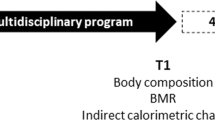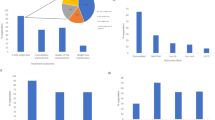Abstract
OBJECTIVE: To compare the influence of weight-reducing diets containing different amounts of protein and CHO on body composition in obese adolescents and to examine dietary and physical activity behaviours during follow-up.
METHODOLOGY: Design: Prospective randomised study comparing two weight-reducing diets with the same energy (1750 kcal) and fat (31%) content, but different protein and carbohydrate contents: PROT− (15% protein, 54% CHO) vs PROT+ (19% protein, 50% CHO). Patients: Massively obese 11- to 16-year-old children (32 boys and 89 girls). Setting: A 9-month treatment in a medical centre (boarding school) plus a 2-y follow-up in free-living patients examined at home 1 and 2 y after treatment. Measurements: Anthropometry, bioelectrical impedance, nutritional intakes and physical activity.
RESULTS: Of the 121 eligible children (61 in PROT− and 60 in PROT+), 82% completed the trial until the end of weight loss treatment and 60% were followed 2 y after treatment. Body mass index (BMI) value at inclusion was 36.3 kg/m2 or 4.3 z-scores (2.9–5.9). BMI z-score decreased to 1.7 at the end of treatment and went back to 2.8 (0.8–6.1) 2 y after treatment. This corresponded to a weight loss of 30.3 kg and weight regain of 21.3 kg. After treatment, energy intake increased and physical activity decreased. The contribution of energy ingested at breakfast decreased while snacking increased. For all measurements, no dietary group differences existed at baseline or at any time during the intervention and follow-up.
CONCLUSION: A higher protein content of the diet did not confer any benefit in the treatment of childhood obesity. Substantial weight loss was obtained with a moderately energy-restricted diet and normal fat content. After weight loss, mean weight increased in spite of moderate energy intake, together with a drift towards obesity-associated behavioural patterns. The causes of the inability to adopt normal weight subjects’ behaviour permanently deserve to be investigated further.
This is a preview of subscription content, access via your institution
Access options
Subscribe to this journal
Receive 12 print issues and online access
$259.00 per year
only $21.58 per issue
Buy this article
- Purchase on Springer Link
- Instant access to full article PDF
Prices may be subject to local taxes which are calculated during checkout

Similar content being viewed by others
References
Wadden TA . Treatment of obesity by moderate and severe caloric restriction. Results of clinical research trials. Ann Intern Med 1993; 119: 688–693.
Blundell JE, Tremblay A . Appetite control and energy (fuel) balance. Nutr Res Rev 1995; 8: 225–242.
Epstein LH, Myers MD, Raynor HA, Saelens MA . Treatment of pediatric obesity. Pediatrics 1998; 101: 554–570.
Troiano RP, Briefel RR, Carroll MD, Bialostroski K . Energy and fat intakes of children and adolescents in the United States: data from the National Health and Nutrition Examination Surveys. Am J Clin Nutr 2000; 72: 1343S–1353S.
Prynne CJ, Paul AA, Price GM, Day KC, Hilder WS, Wadsworth ME . Food and nutrient intake of a national sample of 4-year-old children on 1950: comparison with the 1990s. Public Health Nutr 1999; 2: 537–547.
Rolland-Cachera MF, Bellisle F . Nutrition. In: Burniat W, Lissau I, Cole T (eds) The Obese and Overweight Child. Cambridge University Press: Cambridge, MA; 2002. pp 69–92.
Rosskamp R, Becker M, Soetadji S . Circulating somatomedin-C levels and the effect of growth hormone releasing factor on plasma levels of growth hormone and somatomedin-like immunoreactivity in obese children. Eur J Pediatr 1987; 146: 48–50.
Rolland-Cachera MF, Deheeger M, Akrout M, Bellisle F . Influence of macronutrients on adiposity development: a follow up study of nutrition and growth from 10 months to 8 years of age. Int J Obes Relat Metab Disord 1995; 19: 573–578.
Wabitsch M, Hauner H, Heinze E, Teller W . The role of GH/IGH in adipocyte differentiation. Metabolism 1995; 44 (Suppl): 45–49.
Eisenstein J, Roberts SB, Dallal G, Saltzman E . High-protein weight-loss diets: are they safe and do they work? A review of the experimental and epidemiologic data. Nutr Rev 2002; 60: 189–200.
Rolland-Cachera MF, Cole TJ, Sempé M, Tichet J, Rossignol C, Charraud A . Body mass index variations: centiles from birth to 87 years. Eur J Clin Nutr 1991; 45: 13–21.
National Research Council (US). Recommended Dietary Allowances, 10th edn National Academy Press: Washington, DC; 1989.
WHO expert Commitee. Physical status: the use and interpretation of anthropometry, WHO Technical Report Series no. 854 WHO: Geneva; 1995. pp 368–369.
Boulier A, Fricker J, Thomasset AL, Apfelbaum M . Fat-free mass estimation by the two-electrode impedance model. Am J Clin Nutr 1990; 52: 581–585.
Burke BS . The dietary history as a tool research. J Am Diet Assoc 1947; 23: 1041–1046.
Deheeger M, Bellisle F, Rolland-Cachera MF . The French longitudinal study of growth and nutrition: data in adolescent males and females. J Hum Nutr Diet 2002; 15: 429–438.
Kriska AM, Knowler WC, Hall CB, LaPorte RE, Drash AL, Wing RR, Blair S, Bennett PH, Kuller LH . Development of a questionnaire to examine relationship of physical activity and diabetes in Pima Indians. Diabetes Care 1990; 13: 401–411.
Deheeger M, Rolland-Cachera MF, Fontvieille AM . Physical activity and body composition in 10-year-old children: linkages with nutritional intake? Int J Obes Relat Metab Disord 1997; 21: 372–379.
Ekölbl J, Kartasurya M, Widhalm K . Underestimation of percentage fat mass measured by bioelectrical impedance analysis compared to dual energy X-ray absorptiometry method in obese children. Eur J Clin Nutr 2001; 55: 423–429.
Skov AR, Toubro S, Ronn B, Holm L, Astrup A . Randomized trial on protein vs carbohydrate in ad libitum fat reduced diet for the treatment of obesity. Int J Obes Relat Metab Disord 1999; 23: 528–536.
Figueroa-Colon R, von Almen K, Franklin FA, Schuftan C, Suskind RM . Comparison of two hypocaloric diets in obese children. Am J Dis Child 1993; 147: 160–166.
Hegsted DM, Schuette SA, Zemel MB, Linkswiller HM . Urinary calcium and calcium balance in young men as affected by level of protein and phosphorus intake. J Nutr 1981; 111: 553–562.
Amador M, Ramos LT, Morono M, Hermelo MP . Growth rate reduction during energy restriction in obese adolescents. Exp Clin Endocrinol 1990; 96: 73–82.
Bellisle F, Rolland-Cachera MF, Deheeger M, Guilloud-Bataille M . Obesity and food intake children: evidence for a role of metabolic and/or behavior daily rhythms. Appetite 1988; 11: 111–118.
Kubick MA, Lytle LA, Hannan PJ, Perry CL, Story M . The association of the food school environment with dietary behaviors of young adolescents. Am J Public Health 2003; 93: 1168–1173.
Wing RR, Hill JO . Successful weight loss maintenance. Annu Rev Nutr 2001; 21: 323–341.
Byrne S, Cooper Z, Fairburn C . Weight maintenance and relapse in obesity: a qualitative study. Int J Obes Relat Metab Disord 2003; 27: 955–962.
Acknowledgements
This study was supported by LESIEUR and NESTLE France Companies.
Author information
Authors and Affiliations
Corresponding author
Rights and permissions
About this article
Cite this article
Rolland-Cachera, M., Thibault, H., Souberbielle, J. et al. Massive obesity in adolescents: dietary interventions and behaviours associated with weight regain at 2 y follow-up. Int J Obes 28, 514–519 (2004). https://doi.org/10.1038/sj.ijo.0802605
Received:
Revised:
Accepted:
Published:
Issue Date:
DOI: https://doi.org/10.1038/sj.ijo.0802605
Keywords
This article is cited by
-
Pediatric quality of life multidimensional fatigue scale (PedsQL-MFS) detects the effects of a 3-week Inpatient body weight reduction program for children and adolescents with obesity
Health and Quality of Life Outcomes (2022)
-
Dietary animal and plant protein intakes and their associations with obesity and cardio-metabolic indicators in European adolescents: the HELENA cross-sectional study
Nutrition Journal (2015)
-
Improved insulin sensitivity and body composition, irrespective of macronutrient intake, after a 12 month intervention in adolescents with pre-diabetes; RESIST a randomised control trial
BMC Pediatrics (2014)
-
Changes in body anthropometry and composition in obese adolescents in a lifestyle intervention program
European Journal of Nutrition (2014)
-
Therapie der Adipositas aus sozialpädiatrischer, ernährungstherapeutischer und gesundheitswissenschaftlicher Sicht
Bundesgesundheitsblatt - Gesundheitsforschung - Gesundheitsschutz (2011)



